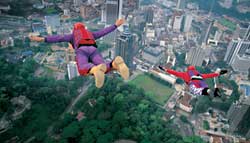ONE MORNING in late August, about 70 gravity addicts will take elevators to the 73rd floors of the Petronas Towers—identical skyscrapers soaring 1,483 feet above downtown Kuala Lumpur, Malaysia. There, they will step out a window onto a five-foot-wide platform and take in the view from the tallest office buildings on earth. Then, one after another, they’ll chuck themselves off.
Event Coverage
For a report on the 2001 BASE-jumping championships, Might as well jump: Californian BASE jumpers Brian Chopin and Henry Boger step off the Menara Kuala Lumpur tower, February 2001.
Might as well jump: Californian BASE jumpers Brian Chopin and Henry Boger step off the Menara Kuala Lumpur tower, February 2001.
The Malaysia International Championship of Skydiving, scheduled for August 27 through September 2, is only the latest high-profile event in a string of state-sanctioned group BASE jumps from the Malaysian capital’s landmarks (which also include 1,381-foot Menara Kuala Lumpur, the world’s fourth-tallest communications tower). Last January during the Malaysia SkyVenture World Record Xtreme Skydive, 15 parachutists celebrated New Year’s by simultaneously jumping from the Petronas Towers and landing gently in a downtown park, where they were presented with medals for “bravery” by Mahathir bin Mohamad, Malaysia’s prime minister. His message: Malaysia, a nation best known for its Buddhist temples, is setting up shop as the global mecca of BASE jumping, a deadly offshoot of skydiving that is vilified in the United States and many other countries because its 2,000-odd practitioners commonly trespass on, and then leap off—frequently with tragic results—rooftops, bridges, radio towers, and cliffs. Devotees insist that with proper equipment and training, the risks of BASE can be made manageable, but since the late seventies it has killed at least 50 people—including Carl Boenish, who in 1978 first popularized the sport when he pitched himself off Yosemite’s 3,604-foot El Capitan (he perished six years later during a leap off a 5,400-foot cliff in Norway).
So how did an activity that first caught headlines in California’s High Sierra find its way across the Pacific to become a Southeast Asian monarchy’s extreme sport du jour? Credit Canadian mechanical engineer and skydiving instructor Martin Dumas, 32, who relocated to Kuala Lumpur in November 1998 to help build a rapid-transit system, but soon found himself planning the country’s first organized BASE jump with two Malaysians, sales and marketing exec Aziz Ahmad, 44, and Rahmat Omar Tunhanif, 34, who owns a furniture factory. Since then, more than 70 of the sport’s disciples—hailing from as far afield as Iceland and Saudi Arabia—have merrily, and legally, flung themselves off Kuala Lumpur buildings.
Of course, it’s a different story in the States, where BASE is infamous for clandestine rooftop sorties and sensational screwups. In the past year, more than a dozen jumpers have been arrested, including Harry Caylor, who last fall leaped off the top of downtown Denver’s Embassy Suites Hotel, only to catch a gust and crash through a window into an unoccupied room. (Bleeding profusely, he walked out of the lobby and called an ambulance, but the cops arrived first and arrested him.) In October 1999, professional stuntwoman Jan Davis perished before 150 spectators when her borrowed chute failed to deploy in an illegal leap off El Cap (BASE jumping is still against the law in America’s national parks). Ironically, Davis’s jump had been intended to memorialize Frank Gambalie III, who only four months before had drowned in the Merced River while fleeing park rangers after his own illicit leap from El Cap (see “,” October 1999).
While short on 3,000-foot cliffs, Kuala Lumpur does not lack for lofty launchpads—the city has 14 buildings over 500 feet high. Further, Malaysia aggressively courts extreme sporting events, and has hosted the Asian X-Games and the World Hang Gliding Championships. “If we didn’t take risks, we’d still be in caves,” says Ahmad, who, with 14 launches under his belt, is the nation’s most experienced BASE jumper.
To a country like Malaysia, where tourism is the third-largest source of domestic revenue, the specter of deaths like those in the U.S. is apparently outshoneby the dazzle of dollar signs. As of early summer, the management of the Menara Kuala Lumpur tower was jockeying with SkyVenture Productions—the promoters of the events at the Petronas Towers. Both want to ink lucrative broadcast contracts with America’s cable networks. But to one veteran jumper, this is a sport that will never, by its very nature, neatly lend itself to prime time. “The accident rate is a natural deterrent,” says Oklahoma geologist Mark Herndon, 40, who logged 100 leaps in the 1980s but packed away his parachute after his son was born. Plus, he says, “Illegal is nice because it keeps the riffraff away.”
Search and Revenue
Injured mountaineers find themselves in the crosshairs of cost-cutting lawmakers
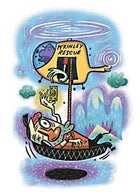
SIXTY-ONE-YEAR-OLD Georgian climber Lev Sarkisov was not thinking of his pocketbook last June as he cradled his broken ribs. Having taken a 20-foot fall on Mount McKinley’s West Buttress route, he watched the approaching U.S. Army Chinook helicopter sent to pluck him from a camp at 14,200 feet. Like the 13 other climbing parties that had to be rescued from McKinley that season, Sarkisov was more concerned with getting the hell off the mountain than with the $13,294 the National Park Service and U.S. Army were spending to save him. But a report commissioned by Congress and scheduled for release this August may have future McKinley climbers checking their credit lines before strapping on their crampons.
Since 1998, when two Brits were choppered off the summit to the tune of $221,818, Alaska Republican Senator Frank Murkowski has argued that evacuating injured climbers from the slopes of McKinley is an unfair burden to taxpayers. Public Law 106-486, authored by Murkowski and signed into law last November, requires the Park Service to suggest ways to recover the costs of emergency evacuations. The new congressional report may recommend that climbers be forced to carry insurance and agree to foot the cost of potential bailouts–which could serve as a precedent for adopting similar practices in other rescue hot spots such as Washington’s Mount Rainier and Northern California’s Mount Shasta.
Mike Gauthier, chief climbing ranger for Mount Rainier National Park, contends that alpinists on McKinley are being unfairly picked on. Of the 1,200 people who attempt McKinley each year, an average of 11 require assistance, a small percentage of the 5,000 or so recreationists the Park Service extracts from the wilderness every year. “As a group, mountain climbers aren’t the most expensive to rescue,” says Gauthier, who points out that more money is spent on tracking down lost hikers. Not surprisingly, the idea that climbers should have to foot the bill for their helicopter ride home doesn’t sit well with the American Alpine Club. “If people think they’re paying for their rescue,” says executive director Charley Shimanski, “they tend to delay calling for help.”
Andrew McEwan
Meet the ruler of the nation’s gnarliest paddle sport
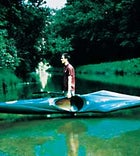 Wild thing: McEwan at the Potomac River near Seneca, Maryland, May 2001
Wild thing: McEwan at the Potomac River near Seneca, Maryland, May 2001Age: 21.
Hometown: Germantown, Maryland.
Years kayaking: 15.
Years “wildwater” racing, a sport that involves steep 20-mile runs down Class III+ rivers: six.
Odds someone will beat McEwan when he defends his title in the National Wildwater Championships on the Pigeon River in eastern Tennessee this month: near-zilch.
Reason McEwan keeps winning, according to teammate Chris Hipgrave: “He’s got a paddling gene the rest of us don’t.”
Length, in feet, of McEwan’s wildwater kayak, the Esox: 14.9.
Length, in feet, of the ’87 VW Golf he uses to cart it around: 13.5.
Width, in inches, of Crack in the Rock, the fastest channel on the Class V Upper Youghiogheny racecourse, where McEwan took first last year: 24.
Width, in inches, of the Esox: 23.6.
McEwan’s prerace nutritional regimen: a large Butterfinger and medium Heath Blizzard from Dairy Queen.
Why dominant European wildwater racers have it made, according to Middy Tilghman, 2nd ranked U.S. wildwater kayaker: “They’re sponsored, so they don’t have to work. They can lift weights, paddle, then just sit around playing video games.” Why McEwan can’t afford to sit around: “American paddlers get very little outside financing. We work to support ourselves.”
Why the work is worth it: “Wildwater is so dynamic. It’s kind of like downhill mountain biking, only the mountain is moving too.”
Loot
���ϳԹ��� Essentials, To Go
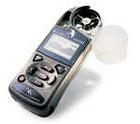


Gear: The Kestrel 4000 Pocket Weather Tracker from Nielsen-Kellerman keeps you dialed in to ten meteorological must-knows, including temperature, wind speed and windchill, barometric pressure, humidity, and heat index. It’s like having Willard Scott in your pocket–minus all the babble. $329;
Video: From the boys who brought you the outrageous Kranked series comes the latest fat-tire masterpiece, Search for the Holey Trail. Watch as ballsy mountain bikers huck their way off buildings and cliffs in Morocco, Switzerland, Australia, Mexico, Spain, France, and Canada. $25;
Book: Alpinist Ed Webster chronicles his five-year tangle with the Goddess Mother in Snow in the Kingdom: My Storm Years on Everest. The self-published book includes an account of his oxygenless, unsupported ascent of the Kangshung Face in 1988. $30;
Web site: Readers of the newly minted Mtb Journal nominate for coverage news and gossip tidbits from across the singletrack universe. Though “reader-generated content”is a dotcom cliche, in this case it actually works.
Reverse Corps
A dam-happy federal agency begins undoing its own legacy
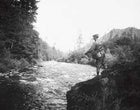 Just add concrete; Washington State’s Green River, circa 1915
Just add concrete; Washington State’s Green River, circa 1915“THIS IS STILL a viable river. It isn’t worth throwing away, really.” A few hundred yards from a Boeing factory and the truck-clogged Port of Seattle, Army Corps of Engineers biologist Patrick Cagney gazes over a stretch of the Green River. He’s admiring a newly constructed side channel full of woody snags that the Corps has installed next to a meat-processing plant in a $113 million effort to “rewild” the river. Cagney hopes the calm, debris-filled channel will provide a resting area for the fall salmon run. Like many urban waterways, the Green has been carefully sculpted over the years–the river has been straightened, diked, riprapped, and made into a well-behaved, navigable ditch. In short, the life has been engineered right out of it. But this summer, a century after the river was first overhauled, the agency that brought you the Snake River dams is attempting to breathe life back into an ecosystem it spent generations subduing.
And that’s just one example. Over the past two years Congress has authorized 50 restoration projects in 25 states, including funds to revive wetlands along the Ohio River and $1.4 billion to resuscitate the hydrology of the Everglades, putting the Corps, known primarily for building large-scale public-works projects, in the business of ecosystem rehabilitation. But enviros are cautious about entrusting habitat remediation to an agency often seen as an environmental bogeyman, especially after last year’s debacle in which the Corps cooked its books to gain support from lawmakers for a dubious $1 billion lock-widening project on the fragile upper Mississippi River. To Melissa Samet, senior director of a Corps-reform campaign at the conservation group American Rivers, some of what the agency labels restoration is plain old engineering. Nevertheless, she hopes that with guidance the Corps can create naturally self-sustaining ecosystems: “We’re making sure that what the Corps does with its restoration is real restoration.”
The Sweet Music of the Line
Saying good-bye to one of the nation’s greatest ski mountaineers
 Saari in Peru, June 2000
Saari in Peru, June 2000ON THE MORNING OF May 8, ski mountaineer Hans Saari and photographer Kristoffer Erickson, Saari’s ski partner, hiked to the top of the Mont Blanc du Tacul for an attempt on the Gervasutti—a 3,000-foot couloir near Chamonix, France. Keen to put a new twist on the run, the two bypassed the usual entrance to the chute in favor of a steeper and more challenging route. A few turns down, Saari, in the lead, slipped on a hidden patch of ice, and then tumbled an estimated 1,500 feet.Despite the quick response of a rescue crew, he died of head trauma. He was 30.
A year before the accident, Saari and Erickson had skied another chute—this one in Montana. They’d dubbed it the Patriarch, in honor of the late Alex Lowe, their climbing partner and mentor, who had perished in an October 1999 avalanche on Tibet’s Mount Shishapangma. One of the nation’s premier ski mountaineers, Saari, a key player in ���ϳԹ���’s feature on the commercial and peer pressures of his sport, was also a talented writer. His lyrical account of that Montana descent could well serve as his epitaph. “To carve turns deliberately and skillfully down the throat of the peak from summit to base creates the line,” he wrote several months later. “The vibrancy of the line means everything. Like a cello, there is no sound until the string is taut. The more you struggle, the tighter the string, the greater the music.”
Smokey’s New Wheels
As another drought-fueled wildfire season looms over the West, a new 27-ton Tonka truck is set to roll into the flames
 Inferno machine: the Proteus Fire Master
Inferno machine: the Proteus Fire MasterYOU’RE A FIRE boss, right? Well, step on over here and feast your eyes on this baby—the Proteus FireMaster, built right here in Missoula and ready for action anywhere you need ‘er. She’ll grab a burning pine, cut it down, give it a good soaking, and drop that bad boy on the safe side of your firebreak—all on a 35-degree slope! She’s also got a helicopter-refillable, 3,000-plus-gallon water tank, a telescoping water cannon, an eight-foot dozer blade, and a boom-mounted grapple claw and 18-inch bar saw.
Not sold yet? Hell, this puppy’s got—all standard features, y’understand—an onboard weather-radio system, outboard video cameras, CD player, air-conditioning, three escape hatches, GPS, and a fire-suppression system that’ll flood the engine compartment and hydraulics with halon gas at the touch of a button on the dash.
Now, I know what you’re thinking. “Wildfire fighting is about tactics,” you’re telling yourself. “That thing between my ears is called a brain, and that’s the most important tool out on the line—not some 27-ton, $350,000 behemoth.” But what you’ve got here is a mechanical army. Last summer, we rolled a Proteus prototype into the Lost Trail Fire, a resort operation right here in the Bitterroots. That burn was sure enough marching down the ski hill. A team went after it with Proteus and a fleet of helicopters, and we stopped it in its tracks.
Now, we both know things are gonna be bad this summer. Last year more than seven million acres went up across the country, and with the drought still hanging on, things aren’t looking much better this season. Hotshots are in short supply. Proteus here is the answer. Just sign this leasing agreement, and we’ll get you set up for just $475 an hour. Wait… Did I tell you about the optional undercoating?


